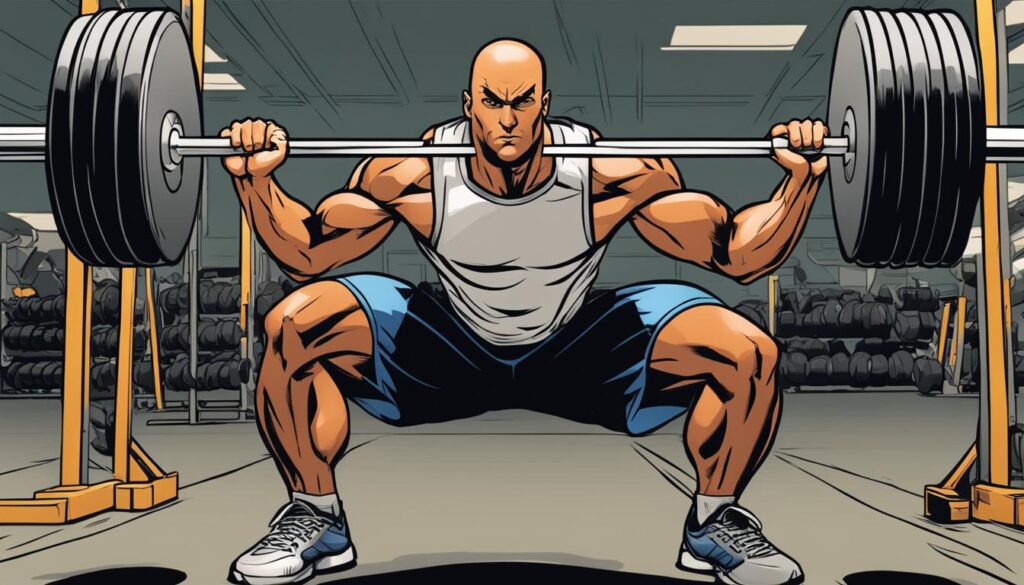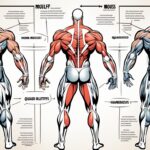Beginner’s Guide: what muscles do deadlifts work
Did you know that deadlifts are one of the most effective exercises for targeting multiple muscle groups simultaneously? When it comes to building strength and muscle, deadlifts are a powerhouse that can deliver jaw-dropping results.
In this beginner’s guide, I will explain the muscles targeted by deadlifts and how incorporating this exercise into your workout routine can lead to significant gains in strength and muscle development. From the glutes to the erector spinae, each muscle plays a crucial role in executing a proper deadlift and reaping the benefits.
Key Takeaways:
- Deadlifts are a highly efficient exercise that engages multiple muscle groups simultaneously.
- The main muscles targeted by deadlifts include the glutes, hamstrings, quadriceps, erector spinae, and trapezius muscles.
- Deadlifts also engage the core muscles, contributing to improved overall strength and stability.
- By incorporating deadlifts into your workout routine, you can enhance your strength, build muscle, and improve overall performance.
- There are various deadlift variations and additional exercises that can complement your training and target specific muscle groups.
Understanding Deadlifts and their Benefits
Before diving into the specific muscles worked by deadlifts, it’s important to understand the exercise itself and the many benefits it offers. Deadlifts are a compound movement that primarily targets the posterior chain, making it an excellent exercise for building overall strength and power.
When performing a deadlift, you start by standing with a loaded barbell on the floor. Then, by bending at the hips and knees, you lift the barbell while keeping your back straight and your core engaged. The movement involves multiple muscle groups working together, which not only builds strength but also improves coordination and stability.
One of the key benefits of deadlifts is their ability to enhance your performance in other exercises. By strengthening the muscles involved in deadlifts, such as the glutes, hamstrings, and lower back, you can improve your performance in squats, lunges, and other lower body exercises. Deadlifts also engage the muscles in your upper body, including the grip, which can improve your ability to lift and hold heavy weights.
In addition to its impact on strength and performance, deadlifts also provide a range of other benefits. By engaging multiple muscle groups and promoting full-body coordination, deadlifts can help increase muscle mass, promote fat loss, and boost metabolism. Furthermore, deadlifts improve bone density, enhance posture, and strengthen the core muscles, leading to better stability and reduced risk of injury.
“Deadlifts are a compound movement that targets the posterior chain, making it one of the most beneficial exercises for overall strength and power.”
To incorporate deadlifts into your workout routine, it’s important to start with proper form and gradually increase the weight as you become more comfortable and proficient. It’s recommended to perform deadlifts 1-2 times per week, allowing sufficient rest and recovery between sessions.
Benefits of Deadlifts:
- Builds overall strength and power
- Enhances performance in other exercises
- Promotes muscle growth and fat loss
- Improves bone density
- Enhances posture and core stability
- Reduces the risk of injury
| Muscles Targeted | Main Benefits |
|---|---|
| Glutes | Improve hip strength and power |
| Hamstrings | Develop leg muscles and improve knee stability |
| Quadriceps | Strengthen the front of the thigh and support knee extension |
| Erector spinae (lower back) | Enhance back strength and promote proper posture |
| Trapezius muscles | Strengthen the upper back and improve shoulder stability |
Muscles Targeted by Deadlifts
Deadlifts work multiple muscle groups simultaneously, making it a highly efficient exercise. When performing deadlifts, you engage several key muscles in your body, including:
- Glutes: The gluteus maximus, commonly known as the glutes, is one of the largest muscles in your body. It is primarily responsible for hip extension and provides power and stability during deadlifts.
- Hamstrings: The hamstrings are a group of muscles located on the back of your thigh. They play a crucial role in hip extension and knee flexion, making them essential for the lifting phase of deadlifts.
- Quadriceps: The quadriceps, often referred to as quads, are a group of four muscles located on the front of your thigh. They are responsible for knee extension and play a significant role in the initial phase of the deadlift movement.
- Erector Spinae (Lower Back): The erector spinae muscles run along your spine and help maintain an upright posture. They provide stability and support to your lower back during deadlifts.
- Trapezius Muscles: The trapezius muscles, commonly known as traps, are located on the upper back and neck. They help stabilize the shoulder blades and play a role in maintaining proper posture and shoulder position during deadlifts.
Engaging these muscles through deadlifts offers several benefits, including:
- Developing lower body strength
- Improving posture
- Promoting overall muscle growth
By incorporating deadlifts into your workout routine, you can target these muscles effectively and experience significant gains in strength and muscle development.

Core Engagement in Deadlifts
In addition to the posterior chain muscles mentioned earlier, deadlifts also engage the core muscles. This includes the rectus abdominis, obliques, and deep stabilizing muscles of the spine. To perform a proper deadlift, you need to maintain a stable and strong core, which further enhances the benefits of this exercise for overall strength and stability.
Engaging the core muscles during deadlifts not only helps to support the spine but also improves your overall posture and balance. The rectus abdominis, commonly known as the “six-pack” muscles, play a significant role in stabilizing the trunk and preventing excessive spinal flexion or extension. The obliques, located on the sides of the abdomen, aid in rotational movements and provide additional stability.
Furthermore, the deep stabilizing muscles of the spine, such as the erector spinae, transverse abdominis, and multifidus, work together with the core muscles to maintain proper alignment and prevent spinal injuries during the deadlift movement.
“Engaging the core muscles during deadlifts is crucial for maintaining proper form and preventing injury. A strong core not only facilitates better performance but also reduces the risk of lower back pain and other biomechanical issues.”
By incorporating deadlifts into your workout routine, you can effectively strengthen and tone your core muscles, leading to improvements in overall stability and functional strength. Adding variations of deadlifts, such as the sumo deadlift or Romanian deadlift, can specifically target different areas of the core and provide additional challenges.
Remember, proper form is key when engaging the core during deadlifts. To maximize the benefits and minimize the risk of injury, focus on bracing your core, maintaining a neutral spine, and engaging your abdominal muscles throughout the entire movement.
Benefits of Core Engagement in Deadlifts:
- Enhanced overall strength and stability
- Improved posture and balance
- Injury prevention and reduced risk of lower back pain
- Strengthened core muscles, including rectus abdominis and obliques
- Increased engagement of deep stabilizing muscles of the spine
Make sure to prioritize core engagement when performing deadlifts to optimize your workouts and achieve maximum results.
Variations and Additional Exercises
Deadlifts offer a range of variations that you can incorporate into your workout routine to target specific muscles and add variety to your training. These variations can help you break through plateaus, challenge your body in new ways, and keep your workouts exciting.
Here are some popular deadlift variations:
- Sumo Deadlifts: This variation involves taking a wider stance and gripping the barbell inside your legs. It places more emphasis on the glutes and inner thighs.
- Romanian Deadlifts: In this variation, you focus on hinging at the hips and keeping your legs slightly bent. It mainly targets the hamstrings and lower back.
- Trap Bar Deadlifts: Using a trap bar (also known as a hex bar) allows for a more neutral grip and a slightly different movement pattern. It recruits the same muscle groups as the conventional deadlift but may feel less taxing on the lower back.
Additionally, incorporating split squats and grip exercises can complement your deadlift routine and further work the muscles involved.
Split squats are a unilateral exercise that targets the quads, glutes, and hamstrings. They can help improve balance and stability while enhancing lower body strength. Grip exercises, such as farmer’s walks or plate pinches, challenge your forearm muscles and improve your ability to hold onto heavy weights during deadlifts.
Adding these variations and complementary exercises to your training can help you target specific muscle groups, improve overall strength, and prevent workout boredom. Remember to focus on proper form and gradually increase the intensity as you progress.
Conclusion
In conclusion, incorporating deadlifts into your workout routine can provide a wide range of benefits for both beginners and experienced lifters. This powerful exercise targets multiple muscle groups, including the glutes, hamstrings, quadriceps, lower back, trapezius muscles, and the core. By engaging these muscles, deadlifts help to enhance strength, build muscle, and improve overall performance.
Deadlifts are particularly effective in developing lower body strength and improving posture. Additionally, they engage the core muscles, such as the rectus abdominis, obliques, and deep stabilizing muscles of the spine. By maintaining a stable and strong core, deadlifts promote overall strength and stability.
Furthermore, deadlifts offer various variations that can be incorporated into your training program to target specific muscles or add variety to your workouts. Popular variations include sumo deadlifts, Romanian deadlifts, and trap bar deadlifts. Additionally, exercises like split squats and grip exercises can complement your deadlift routine, further working the muscles involved.
Whether you’re a beginner or an experienced lifter, deadlifts are an invaluable addition to any training program. Their ability to work multiple muscle groups simultaneously and promote overall strength and stability makes them a highly efficient and effective exercise. So, start incorporating deadlifts into your workout routine and experience the benefits for yourself!
FAQ
What muscles do deadlifts work?
Deadlifts primarily target the glutes, hamstrings, quadriceps, erector spinae (lower back), and trapezius muscles. These exercises engage multiple muscle groups simultaneously, promoting overall strength and muscle development.
What are the benefits of deadlifts?
Deadlifts offer numerous benefits, including increased strength and muscle mass, improved posture, enhanced power and explosiveness, and increased bone density. Incorporating deadlifts into your workout routine can also enhance performance in other exercises and help prevent injuries.
Do deadlifts engage the core muscles?
Yes, deadlifts engage the core muscles, including the rectus abdominis, obliques, and deep stabilizing muscles of the spine. Maintaining a stable and strong core is essential for proper deadlift form and further enhances the benefits of this exercise for overall strength and stability.
Are there variations of deadlifts?
Yes, deadlifts offer various variations that you can incorporate into your workout routine. Some popular variations include sumo deadlifts, Romanian deadlifts, and trap bar deadlifts. These variations allow you to target specific muscles or add variety to your training.
What are some additional exercises that complement deadlifts?
In addition to deadlifts, exercises like split squats and grip exercises can complement your training routine. Split squats target the lower body muscles, while grip exercises improve hand and forearm strength, which can benefit your deadlift performance.
